Discover Patterns and Mobility of Twitter Users—A Study of Four US College Cities
Abstract
:1. Introduction
2. Study Areas and Data
2.1. Study Areas
2.2. Twitter Data
2.3. Land Use Data
3. Spatial and Temporal Patterns
3.1. Spatial Patterns
3.2. Temporal Patterns
3.3. Spatial-Temporal Patterns
4. User Tweeting Behavior and Mobility
4.1. User Tweet Counts
4.2. User Tweeting Frequency
4.3. User Mobility
5. Conclusions
Acknowledgments
Author Contributions
Conflicts of Interest
References
- Milstein, S.; Lorica, B.; Magoulas, R.; Hochmuth, G.; Chowdhury, A.; O’Reilly, T. Twitter and the Micro-Messaging Revolution: Communication, Connections, and Immediacy--140 Characters at a Time; O’Reilly Media, Inc.: Sebastopol, CA, USA, 2008. [Google Scholar]
- Twitter. Available online: http://en.wikipedia.org/wiki/Twitter (accessed on 13 November 2016).
- Stone, B. Twitter, the startup that wouldn’t die. Bloom. Bus. Week 2012, 1, 62–67. [Google Scholar]
- Lunden, I. Analyst: Twitter passed 500m users in June 2012, 140m of them in US; Jakarta ‘Biggest Tweeting’ city. Available online: https://techcrunch.com/2012/07/30/analyst-twitter-passed-500m-users-in-june-2012-140m-of-them-in-us-jakarta-biggest-tweeting-city/ (accessed on 9 February 2017).
- Leetaru, K.; Wang, S.; Cao, G.; Padmanabhan, A.; Shook, E. Mapping the global Twitter heartbeat: The geography of Twitter. First Monday 2013, 18. [Google Scholar] [CrossRef]
- Miller, G. Social scientists wade into the tweet stream. Science 2011, 333, 1814–1815. [Google Scholar] [CrossRef] [PubMed]
- Steiger, E.; Albuquerque, J.P.; Zipf, A. An Advanced Systematic Literature Review on Spatiotemporal Analyses of Twitter Data. Trans. GIS 2015, 19, 809–834. [Google Scholar] [CrossRef]
- Goodchild, M.F.; Glennon, J.A. Crowdsourcing geographic information for disaster response: A research frontier. Int. J. Digit. Earth 2010, 3, 231–241. [Google Scholar] [CrossRef]
- Jurgens, D.; Finethy, T.; McCorriston, J.; Xu, Y.T.; Ruths, D. Geolocation Prediction in Twitter Using Social Networks: A Critical Analysis and Review of Current Practice. In Proceedings of the 9th International AAAI Conference on Web and Social Media (ICWSM), Oxford, UK, 26–29 May 2015.
- Preoţiuc-Pietro, D.; Cohn, T. Mining user behaviours: A study of check-in patterns in location based social networks. In Proceedings of the 5th Annual ACM Web Science Conference, Paris, France, 2–4 May 2013; pp. 306–315.
- Fujisaka, T.; Lee, R.; Sumiya, K. Discovery of user behavior patterns from geo-tagged micro-blogs. In Proceedings of the 4th International Conference on Ubiquitous Information Management and Communication, Suwon, Korea, 14–15 January 2010.
- Goodchild, M.F. Citizens as sensors: The world of volunteered geography. GeoJournal 2007, 69, 211–221. [Google Scholar] [CrossRef]
- Carley, K.M.; Malik, M.; Landwehr, P.M.; Pfeffer, J.; Kowalchuck, M. Crowd sourcing disaster management: The complex nature of Twitter usage in Padang Indonesia. Saf. Sci. 2016, 90, 48–61. [Google Scholar] [CrossRef]
- Stevenson, J.R.; Emrich, C.T.; Mitchell, J.T.; Cutter, S.L. Using building permits to monitor disaster recovery: A spatio-temporal case study of coastal Mississippi following Hurricane Katrina. Cartogr. Geogr. Inf. Sci. 2010, 37, 57–68. [Google Scholar] [CrossRef]
- Granell, C.; Ostermann, F.O. Beyond data collection: Objectives and methods of research using VGI and geo-social media for disaster management. Comput. Environ. Urban Syst. 2016, 59, 231–243. [Google Scholar] [CrossRef]
- Zook, M.; Graham, M.; Shelton, T.; Gorman, S. Volunteered geographic information and crowdsourcing disaster relief: A case study of the Haitian earthquake. World Med. Health Policy 2010, 2, 7–33. [Google Scholar] [CrossRef]
- Arcaini, P.; Bordogna, G.; Ienco, D.; Sterlacchini, S. User-driven geo-temporal density-based exploration of periodic and not periodic events reported in social networks. Inf. Sci. 2016, 340, 122–143. [Google Scholar] [CrossRef] [Green Version]
- Nakaji, Y.; Yanai, K. Visualization of real-world events with geotagged tweet photos. In Proceedings of the IEEE International Conference on Multimedia and Expo Workshops (ICMEW), Melbourne, Australia, 9–13 July 2012; pp. 272–277.
- Crampton, J.W.; Graham, M.; Poorthuis, A.; Shelton, T.; Stephens, M.; Wilson, M.W.; Zook, M. Beyond the geotag: Situating ‘big data’ and leveraging the potential of the geoweb. Cartogr. Geogr. Inf. Sci. 2013, 40, 130–139. [Google Scholar] [CrossRef]
- Tsou, M.H.; Leitner, M. Visualization of social media: Seeing a mirage or a message? Cartogr. Geogr. Inf. Sci. 2013, 40, 55–60. [Google Scholar] [CrossRef]
- Tsou, M.H.; Yang, J.A.; Lusher, D.; Han, S.; Spitzberg, B.; Gawron, J.M.; An, L. Mapping social activities and concepts with social media (Twitter) and web search engines (Yahoo and Bing): A case study in 2012 US Presidential Election. Cartogr. Geogr. Inf. Sci. 2013, 40, 337–348. [Google Scholar] [CrossRef]
- Ghosh, D.; Guha, R. What are we ‘tweeting’ about obesity? Mapping tweets with topic modeling and Geographic Information System. Cartogr. Geogr. Inf. Sci. 2013, 40, 90–102. [Google Scholar] [CrossRef] [PubMed]
- Holderness, T.; Kennedy-Walker, R.; Alderson, D.; Evans, B. An evaluation of spatial network modelling to aid sanitation planning in informal settlements using crowd-sourced data. In Proceedings of the International Symposium for Next Generation Infrastructure, Wollongong, Australia, 1–4 October 2013; pp. 185–192.
- Roick, O.; Heuser, S. Location based social networks–definition, current state of the art and research Agenda. Trans. GIS 2013, 17, 763–784. [Google Scholar] [CrossRef]
- Gonzalez, M.C.; Hidalgo, C.A.; Barabasi, A.L. Understanding individual human mobility patterns. Nature 2008, 453, 779–782. [Google Scholar] [CrossRef] [PubMed]
- Hawelka, B.; Sitko, I.; Beinat, E.; Sobolevsky, S.; Kazakopoulos, P.; Ratti, C. Geo-located Twitter as proxy for global mobility patterns. Cartogr. Geogr. Inf. Sci. 2014, 41, 260–271. [Google Scholar] [CrossRef] [PubMed]
- Caverlee, J.; Cheng, Z.; Sui, D.Z.; Kamath, K.Y. Towards Geo-Social Intelligence: Mining, Analyzing, and Leveraging Geospatial Footprints in Social Media. IEEE Data Eng. Bull. 2013, 36, 33–41. [Google Scholar]
- Peng, C.; Jin, X.; Wong, K.; Shi, M.; Lio, P. Collective human mobility pattern from taxi trips in urban area. PLoS ONE 2012, 7, e34487. [Google Scholar]
- Liu, Y.; Wang, F.; Xiao, Y.; Gao, S. Urban land uses and traffic ’source-sink areas’: Evidence from GPS-enabled taxi data in Shanghai. Landsc. Urban Plan. 2012, 106, 73–87. [Google Scholar] [CrossRef]
- Zheng, V.; Zheng, Y.; Xie, X.; Yang, Q. Towards mobile intelligence: Learning from GPS history data for collaborative recommendation. Artif. Intell. 2012, 184, 17–37. [Google Scholar] [CrossRef]
- Cheng, Z.; Caverlee, J.; Lee, K.; Sui, D. Exploring millions of footprints in location sharing services. In Proceedings of the Fifth International AAAI Conference on Weblogs and Social Media, Barcelona, Spain, 17–21 July 2011 ; pp. 81–88.
- Liang, X.; Zhao, J.; Dong, L.; Xu, K. Unraveling the origin of exponential law in intra-urban human mobility. Sci. Rep. 2013, 3, 2983. [Google Scholar] [CrossRef] [PubMed]
- Bagrow, J.P.; Lin, Y. Mesoscopic structure and social aspects of human mobility. PLoS ONE 2012, 7, e37676. [Google Scholar] [CrossRef] [PubMed]
- Bayir, M.A.; Demirbas, M.; Eagle, N. Discovering spatiotemporal mobility profiles of cellphone users. In Proceedings of the 2009 IEEE International Symposium on a “World of Wireless, Mobile and Multimedia Networks & Workshops” (WoWMoM 2009), Kos, Greece, 15–19 June 2009; pp. 1–9.
- Yang, X.; Fang, Z.; Xu, Y.; Shaw, S.L.; Zhao, Z.; Yin, L.; Zhang, T.; Lin, Y. Understanding Spatiotemporal Patterns of Human Convergence and Divergence Using Mobile Phone Location Data. ISPRS Int. J. Geo-Inf. 2016, 5, 177. [Google Scholar] [CrossRef]
- Hasan, S.; Schneider, C.M.; Ukkusuri, S.V.; González, M.C. Spatiotemporal patterns of urban human mobility. J. Stat. Phys. 2013, 151, 304–318. [Google Scholar] [CrossRef]
- Gong, L.; Liu, X.; Wu, L.; Liu, Y. Inferring trip purposes and uncovering travel patterns from taxi trajectory data. Cartogr. Geogr. Inf. Sci. 2016, 43, 103–114. [Google Scholar] [CrossRef]
- Huang, Q.; Wong, D.W. Activity patterns, socioeconomic status and urban spatial structure: What can social media data tell us? Int. J. Geogr. Inf. Sci. 2016, 30, 1873–1898. [Google Scholar] [CrossRef]
- Gao, S.; Yang, J.A.; Yan, B.; Hu, Y.; Janowicz, K.; McKenzie, G. Detecting Origin-Destination Mobility Flows From Geotagged Tweets in Greater Los Angeles Area. In Proceedings of the Eighth International Conference on Geographic Information Science (GIScience’14), Vienna, Austria, 24–26 September 2014.
- Girardin, F.; Calabrese, F.; Fiore, F.D.; Ratti, C.; Blat, J. Digital footprinting: Uncovering tourists with user-generated content. IEEE Pervasive Comput. 2008, 7, 36–43. [Google Scholar] [CrossRef]
- Leung, R.; Vu, H.Q.; Rong, J.; Miao, Y. Tourists Visit and Photo Sharing Behavior Analysis: A Case Study of Hong Kong Temples. In Information and Communication Technologies in Tourism 2016; Springer International Publishing: Cham, Switzerland, 2016; pp. 197–209. [Google Scholar]
- Popescu, A.; Grefenstette, G.; Moëllic, P.A. Mining tourist information from user-supplied collections. In Proceedings of the 18th ACM conference on Information and knowledge management, Hong Kong, China, 2–6 November 2009; pp. 1713–1716.
- Li, L.; Goodchild, M.F.; Xu, B. Spatial, temporal, and socioeconomic patterns in the use of Twitter and Flickr. Cartogr. Geogr. Inf. Sci. 2013, 40, 61–77. [Google Scholar] [CrossRef]
- Li, Y.; Shan, J. Understanding the Spatio-temporal Pattern of Tweets. Photogramm. Eng. Remote Sens. 2013, 79, 769–773. [Google Scholar]
- West Lafayette, Indiana. Available online: http://en.wikipedia.org/wiki/West_Lafayette,_Indiana (accessed on 5 November 2014).
- Purdue University. Available online: http://en.wikipedia.org/wiki/Purdue_University (accessed on 1 August 2013).
- Bloomington, Indiana. Available online: http://en.wikipedia.org/wiki/Bloomington,_Indiana (accessed on 5 November 2014).
- Housing. Available online: http://www.iub.edu/student/housing.shtml (accessed on 5 November 2014).
- Ann Arbor, Michigan. Available online: http://en.wikipedia.org/wiki/Ann_Arbor,_Michigan (accessed on 6 November 2014).
- Housing Options. Available online: http://housing.umich.edu/options (accessed on 6 November 2014).
- Columbus, Ohio. Available online: http://en.wikipedia.org/wiki/Columbus,_Ohio (accessed on 6 November 2014).
- The Ohio State University. Available online: http://en.wikipedia.org/wiki/Ohio_State_University (accessed on 6 November 2014).
- The Streaming APIs Overview. Available online: https://dev.twitter.com/streaming/overview (accessed on 6 November 2014).
- Tweepy. Available online: http://www.tweepy.org/ (accessed on 4 February 2017).
- Twitter-Streamer. Available online: https://github.com/inactivist/twitter-streamer (accessed on 4 February 2017).
- API Rate Limit. Available online: https://dev.twitter.com/rest/public/rate-limiting (accessed on 4 February 2017).
- Pesyna, K.M., Jr.; Heath, R.W., Jr.; Humphreys, T.E. Centimeter Positioning with a Smartphone-Quality GNSS Antenna. GPS World, 2 February 2015. Available online: http://gpsworld.com/accuracy-in-the-palm-of-your-hand/ (accessed on 10 January 2017).
- Dempster, A.P.; Laird, N.M.; Rubin, D.B. Maximum likelihood from incomplete data via the EM algorithm. J. R. Stat. Soci. 1977, 39, 1–38. [Google Scholar]
- Aggarwal, C.C.; Reddy, C.K. Data Clustering: Algorithms and Applications; CRC Press: Boca Raton, FL, USA, 2013. [Google Scholar]
- Gan, G.; Ma, C.; Wu, J. Data Clustering: Theory, Algorithms, and Applications; SIAM: Philadelphia, PA, USA, 2007; Volume 20. [Google Scholar]
- Ambroise, C.; Dang, M.; Govaert, G. Clustering of spatial data by the EM algorithm. In geoENV I—Geostatistics for Environmental Applications; Springer Science+Business Media B.V.: Dordrecht, The Netherlands, 1997; pp. 493–504. [Google Scholar]
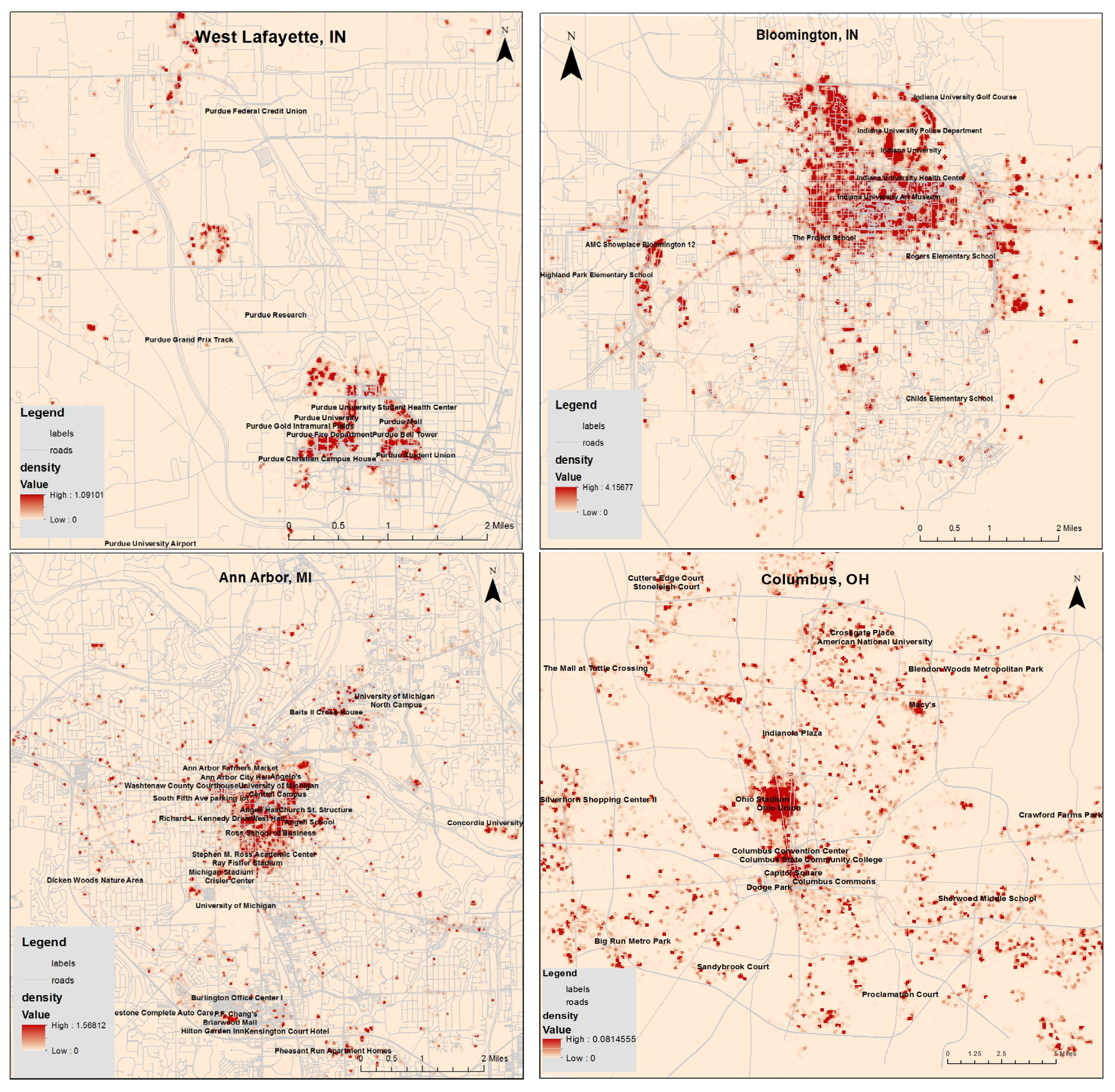
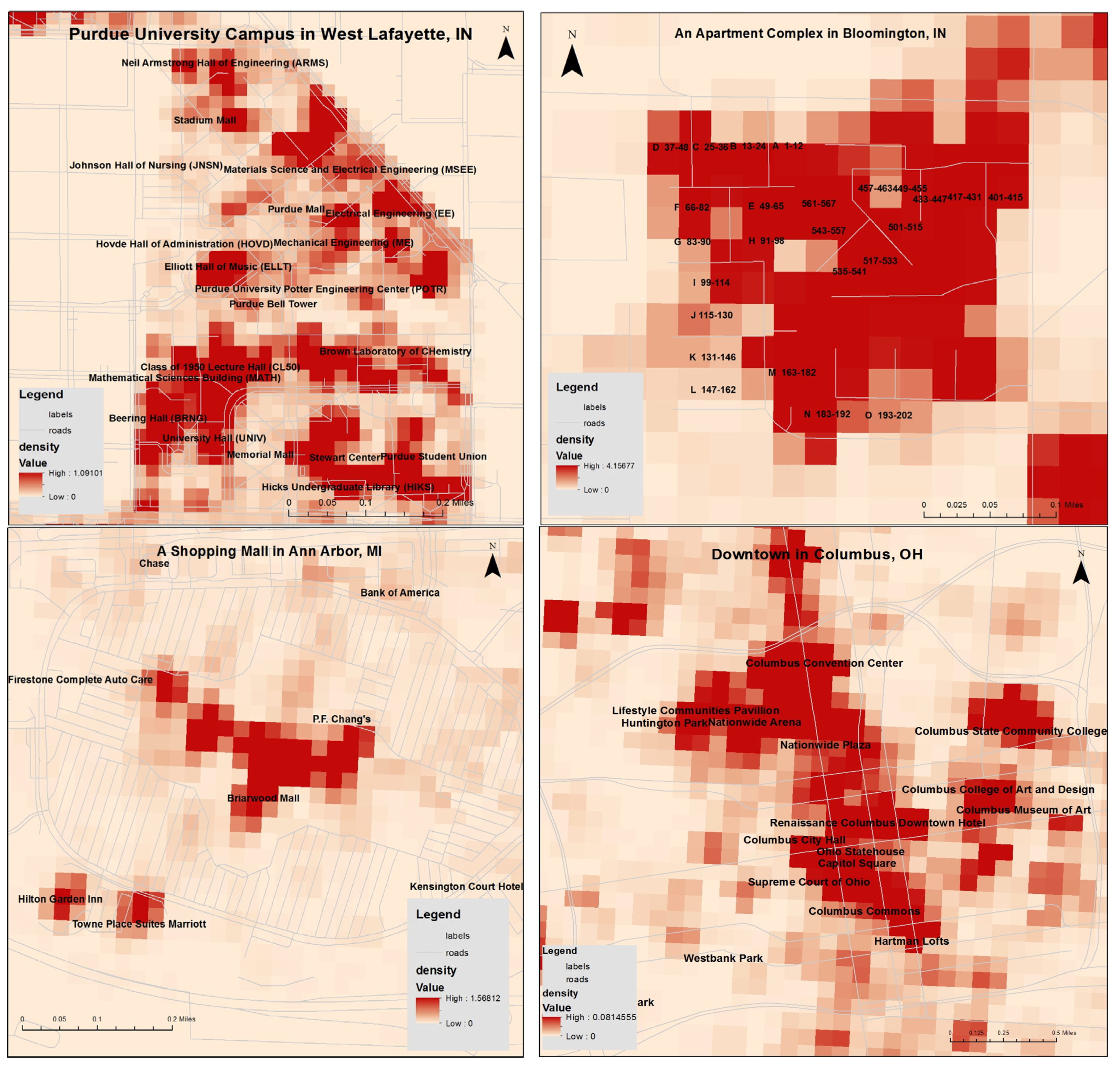
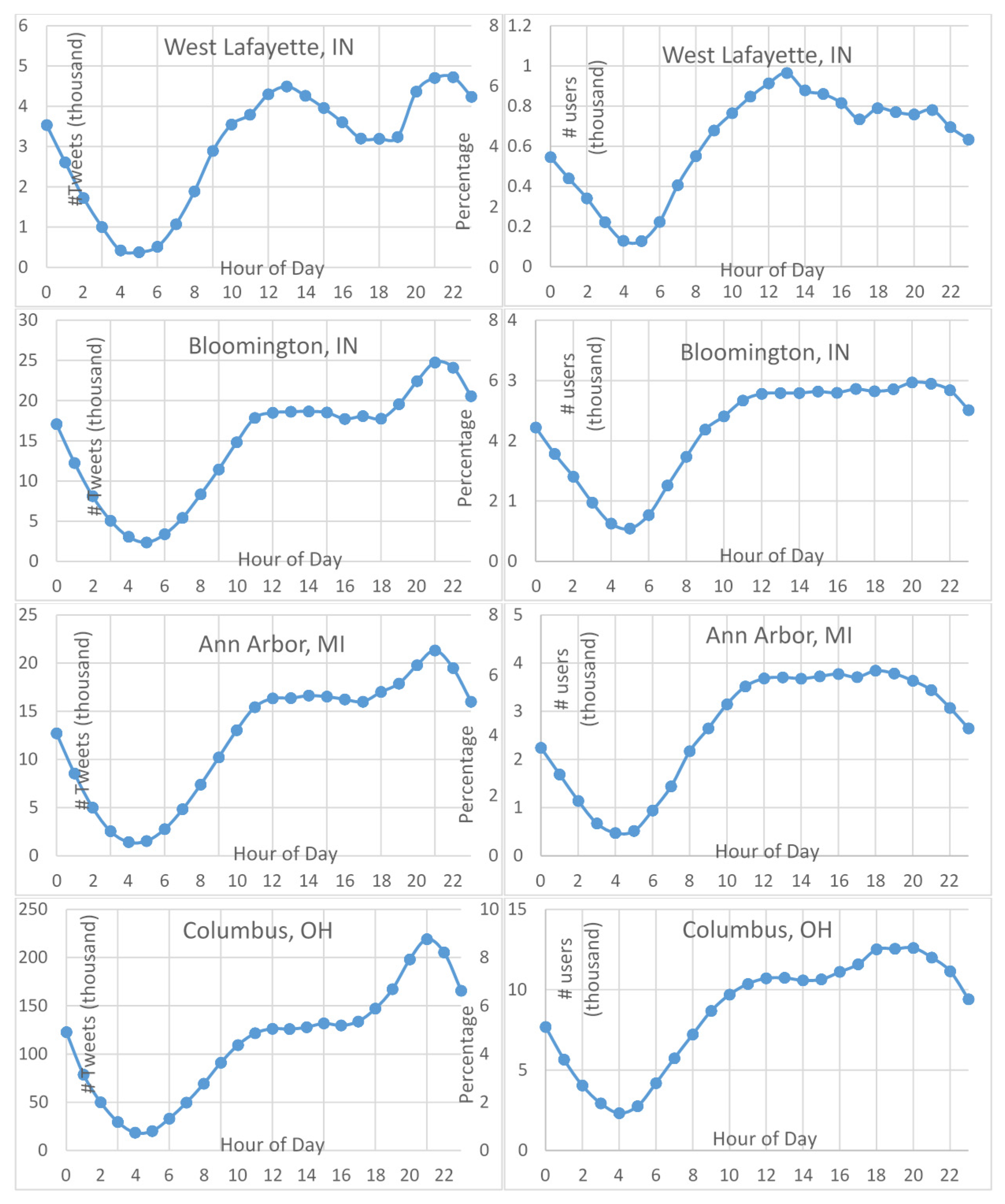
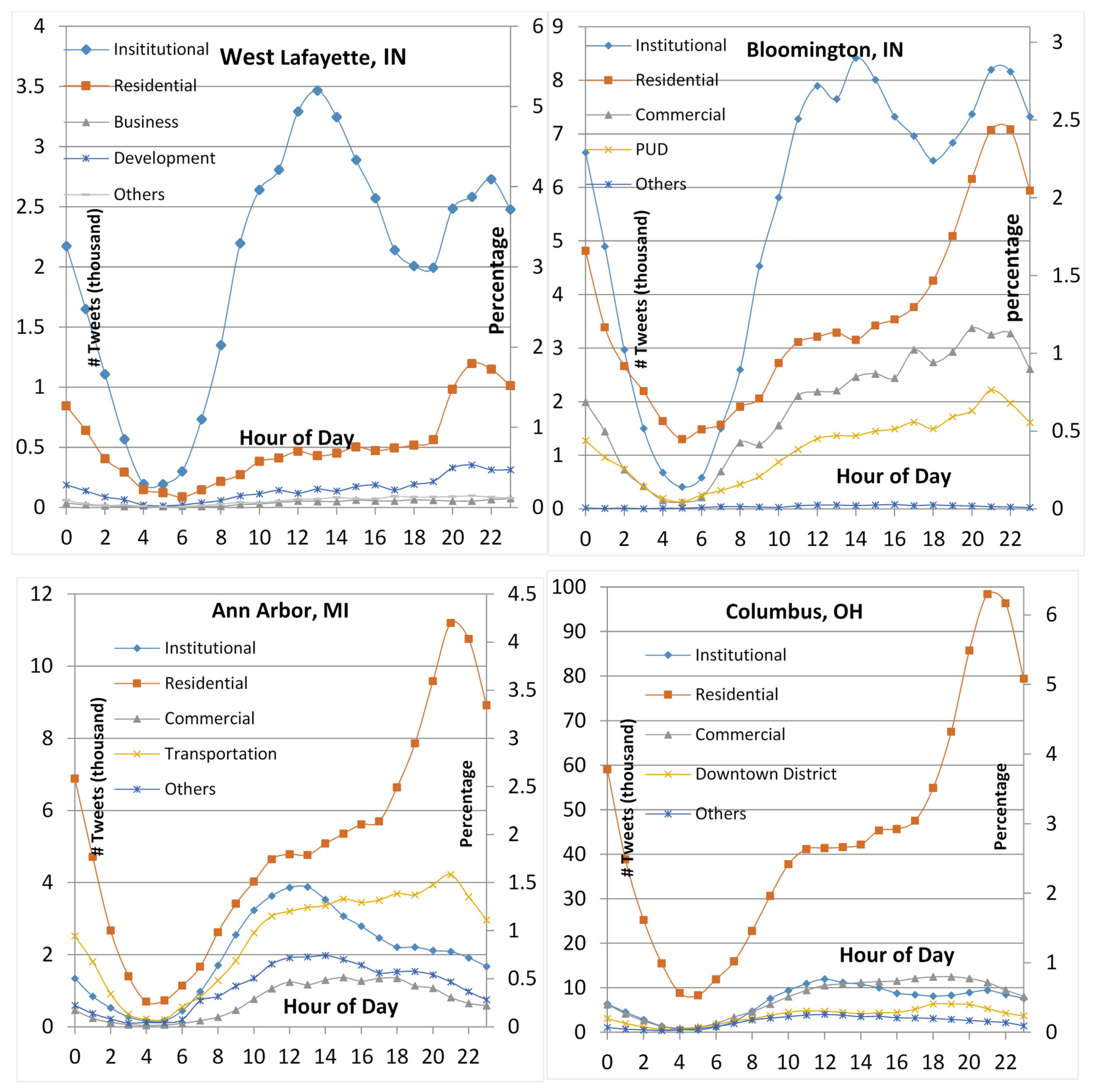

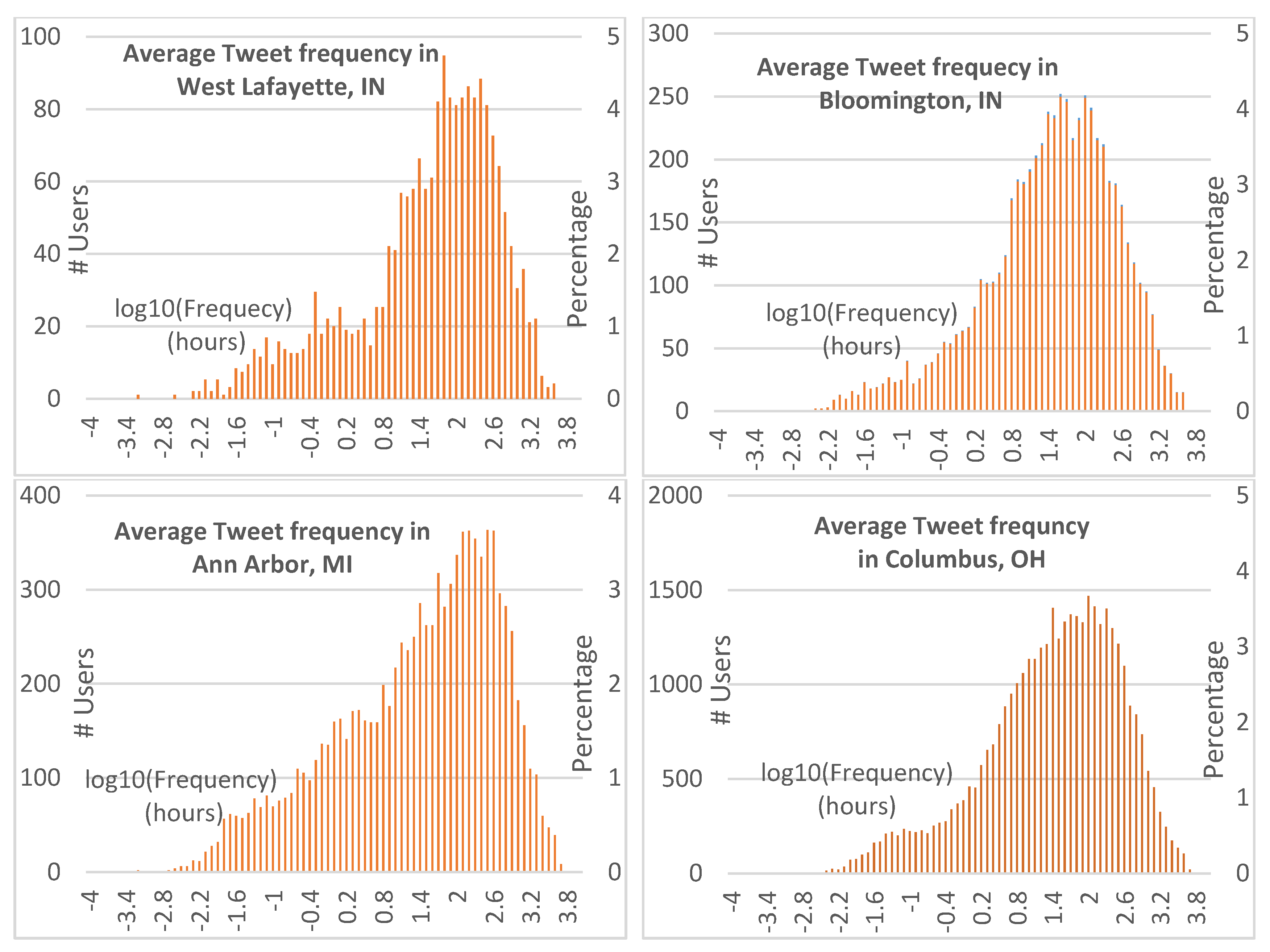
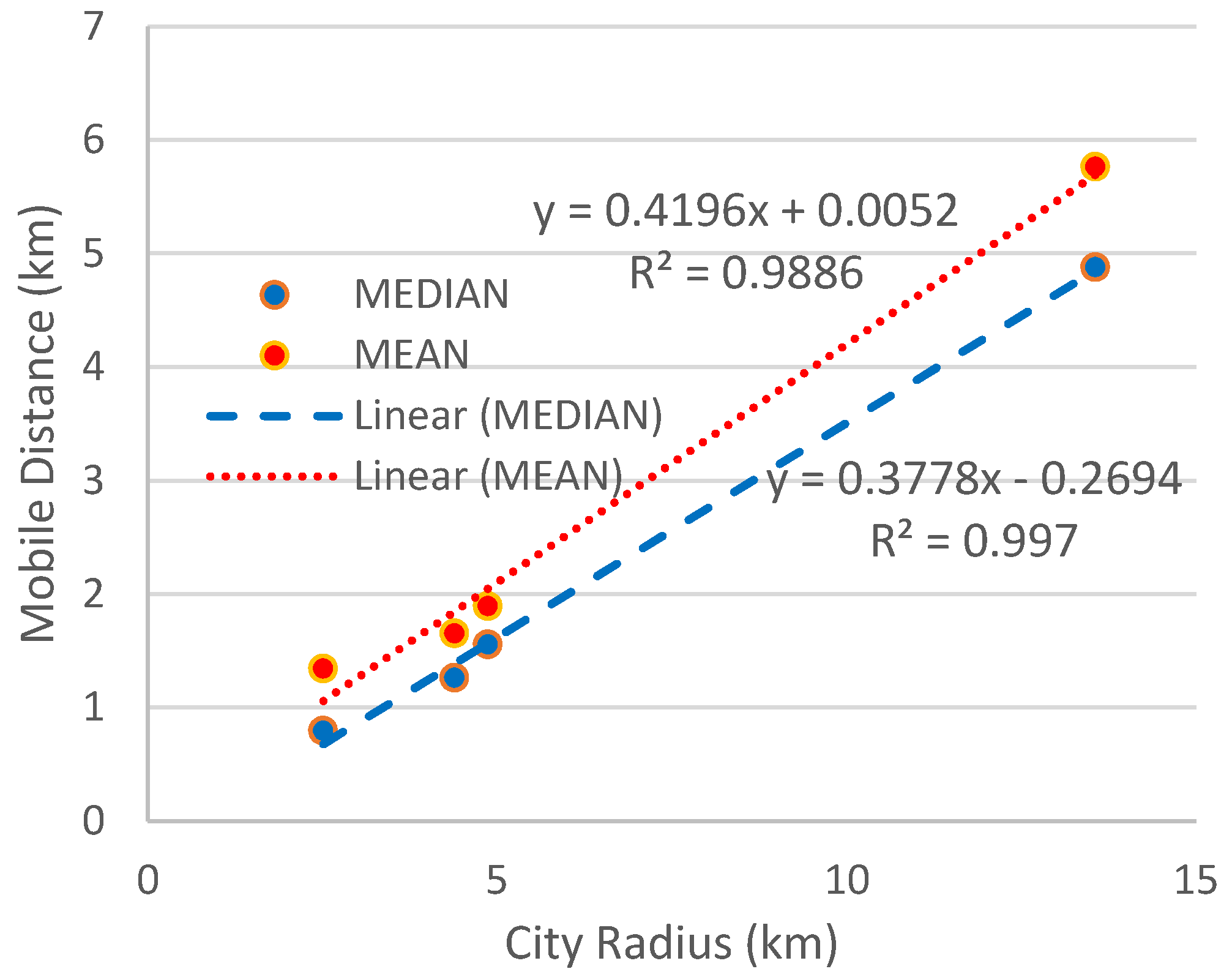

| City/Area | Population | Size (km2) | Lower-Left (Deg.) | Upper-Right (Deg.) |
|---|---|---|---|---|
| West Lafayette, IN | 29,596 | 19.76 | (−86.970, 40.414) | (−86.896, 40.475) |
| Bloomington, IN | 80,405 | 60.50 | (−86.623, 39.102) | (−86.473, 39.196) |
| Ann Arbor, MI | 113,934 | 74.33 | (−83.804, 42.221) | (−83.674, 42.322) |
| Columbus, OH | 822,553 | 577.85 | (−83.195, 39.843) | (−82.773, 40.204) |
| Study Area | West Lafayette | Bloomington | Ann Arbor | Columbus |
|---|---|---|---|---|
| # Tweets | 71,658 | 348,478 | 295,057 | 2,671,648 |
| # Users | 2884 | 8336 | 15,394 | 52,149 |
| Avg. tweets per user | 24.85 | 41.80 | 19.17 | 51.23 |
| # Users with 100+ tweets | 153 | 725 | 571 | 2661 |
| % Frequent users | 5.3% | 8.6% | 3.7% | 5.1% |
| # Tweets from frequent users | 41,402 | 248,549 | 168,138 | 1,071,941 |
| % Tweets from frequent users | 57.7% | 71.3% | 56.9% | 40.1% |
| # Users | West Lafayette | Bloomington | Ann Arbor | Columbus |
|---|---|---|---|---|
| # users on both weekdays and weekends (d) | 391 | 1456 | 1613 | 7401 |
| # users on weekdays (A) | 2137 | 6437 | 11,302 | 41,276 |
| d/A (%) | 18.3 | 22.6 | 14.3 | 17.9 |
| # users on weekends (E) | 1841 | 5766 | 9219 | 35,184 |
| d/E (%) | 21.2 | 25.2 | 17.5 | 21.0 |
| % in Total | West Lafayette | Bloomington | Ann Arbor | Columbus |
|---|---|---|---|---|
| Institutional | 72.60 | 45.61 | 17.67 | 10.39 |
| Residential | 18.52 | 29.39 | 44.75 | 68.48 |
| Commercial | 1.40 | 15.64 | 6.30 | 11.78 |
| City | # Centers | Avg. Distance between Centers | |||||
|---|---|---|---|---|---|---|---|
| 1 | 2 | 3 | 4 | 5 | Mean (km) | Median (km) | |
| West Lafayette | 5.9 | 26.8 | 39.9 | 25.5 | 2.0 | 1.342 | 0.795 |
| Bloomington | 2.1 | 20.1 | 38.8 | 31.6 | 7.4 | 1.651 | 1.260 |
| Ann Arbor | 4.4 | 21.2 | 42.6 | 26.6 | 5.3 | 1.892 | 1.556 |
| Columbus | 12.2 | 31.9 | 33.4 | 18.1 | 4.5 | 5.763 | 4.879 |
© 2017 by the authors. Licensee MDPI, Basel, Switzerland. This article is an open access article distributed under the terms and conditions of the Creative Commons Attribution (CC BY) license ( http://creativecommons.org/licenses/by/4.0/).
Share and Cite
Li, Y.; Li, Q.; Shan, J. Discover Patterns and Mobility of Twitter Users—A Study of Four US College Cities. ISPRS Int. J. Geo-Inf. 2017, 6, 42. https://doi.org/10.3390/ijgi6020042
Li Y, Li Q, Shan J. Discover Patterns and Mobility of Twitter Users—A Study of Four US College Cities. ISPRS International Journal of Geo-Information. 2017; 6(2):42. https://doi.org/10.3390/ijgi6020042
Chicago/Turabian StyleLi, Yue, Qinghua Li, and Jie Shan. 2017. "Discover Patterns and Mobility of Twitter Users—A Study of Four US College Cities" ISPRS International Journal of Geo-Information 6, no. 2: 42. https://doi.org/10.3390/ijgi6020042
APA StyleLi, Y., Li, Q., & Shan, J. (2017). Discover Patterns and Mobility of Twitter Users—A Study of Four US College Cities. ISPRS International Journal of Geo-Information, 6(2), 42. https://doi.org/10.3390/ijgi6020042





